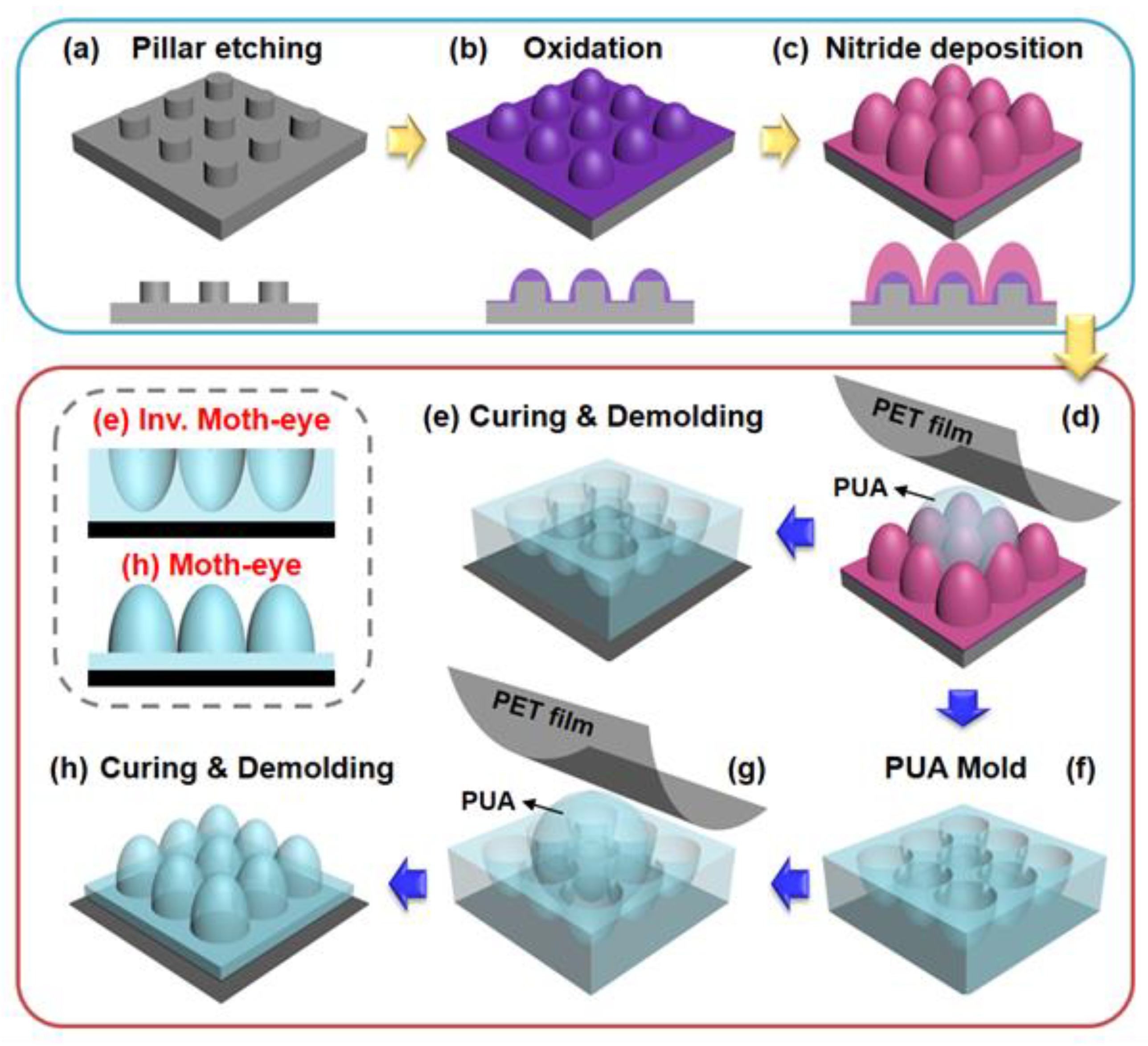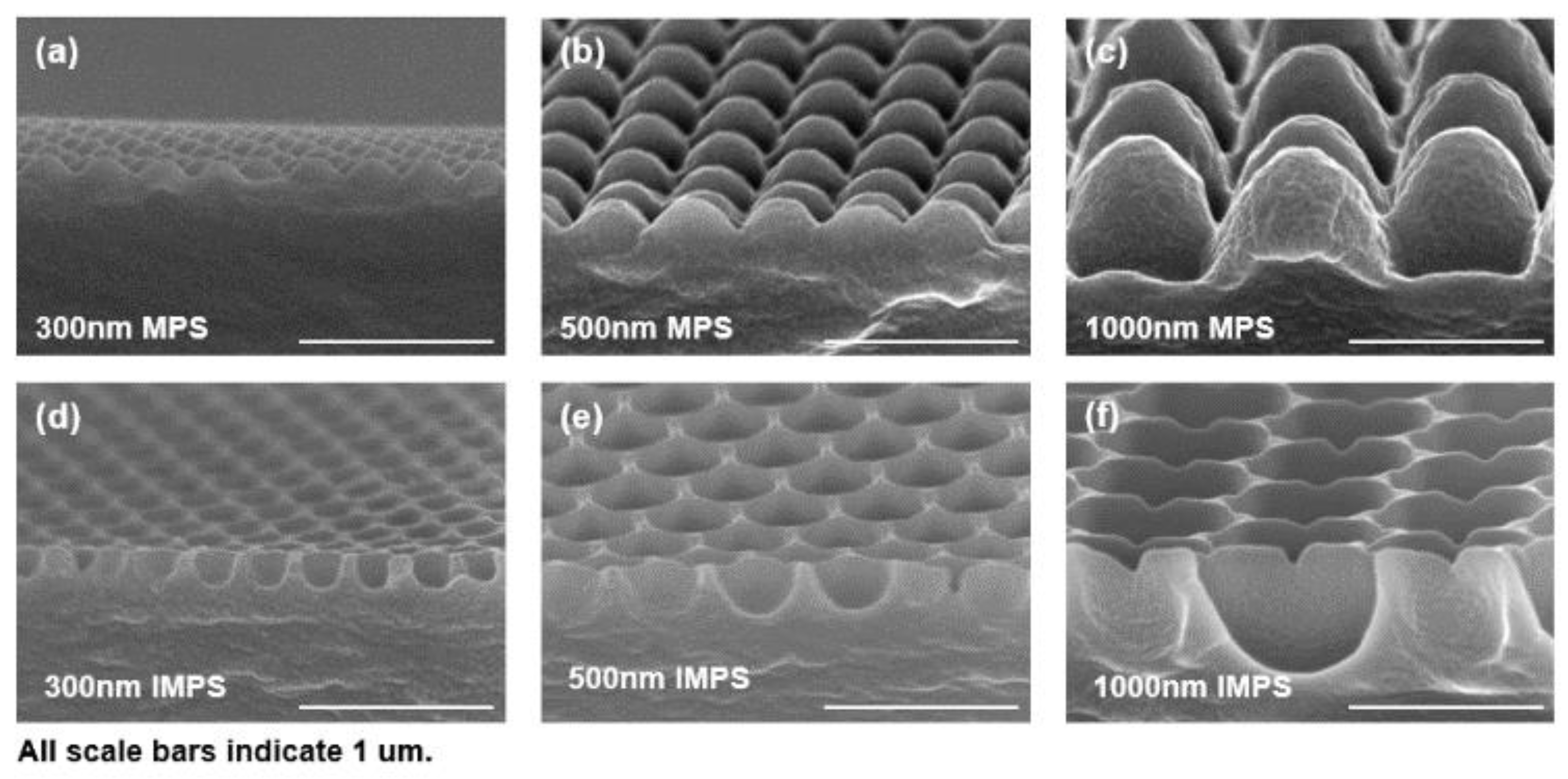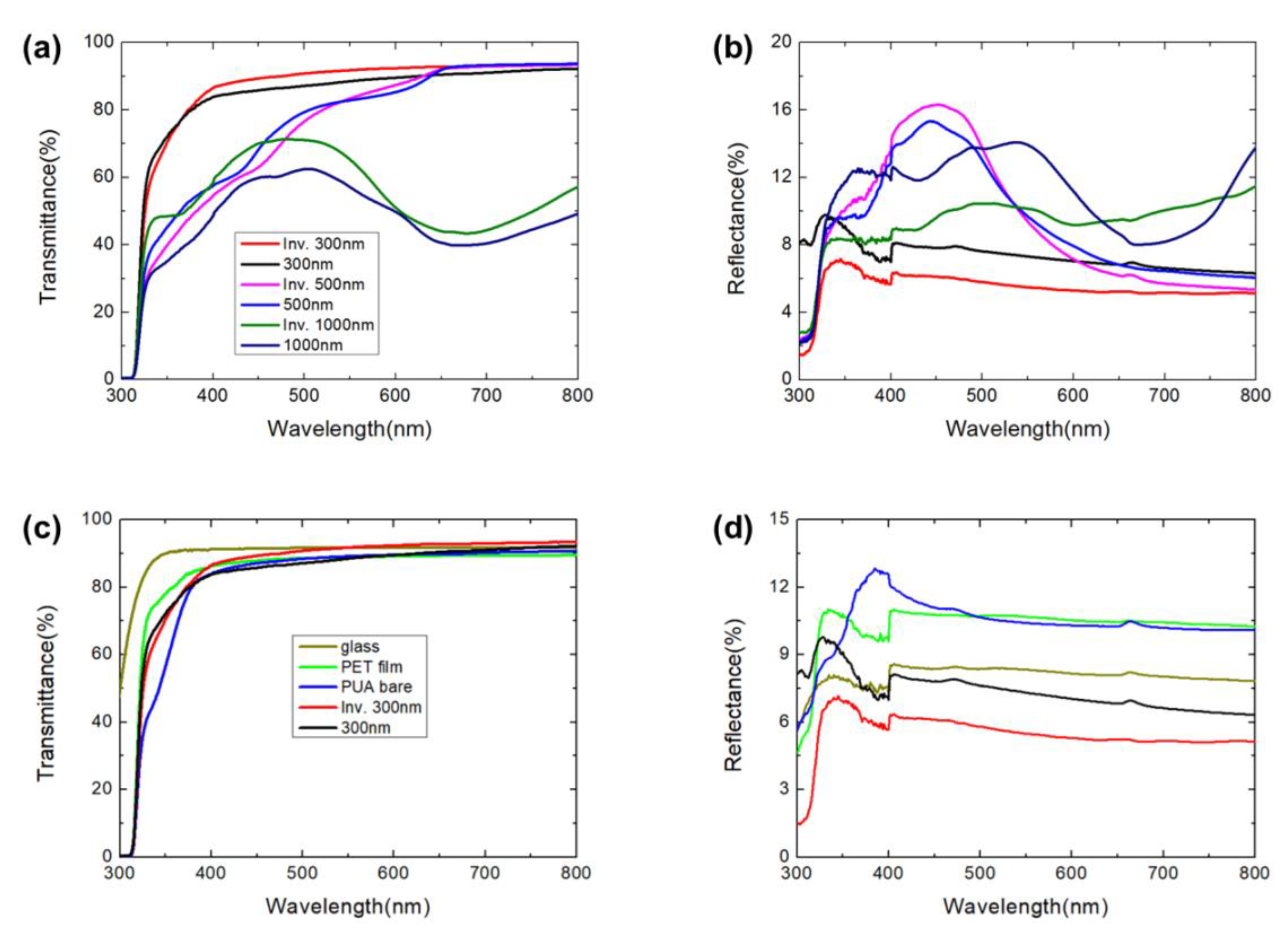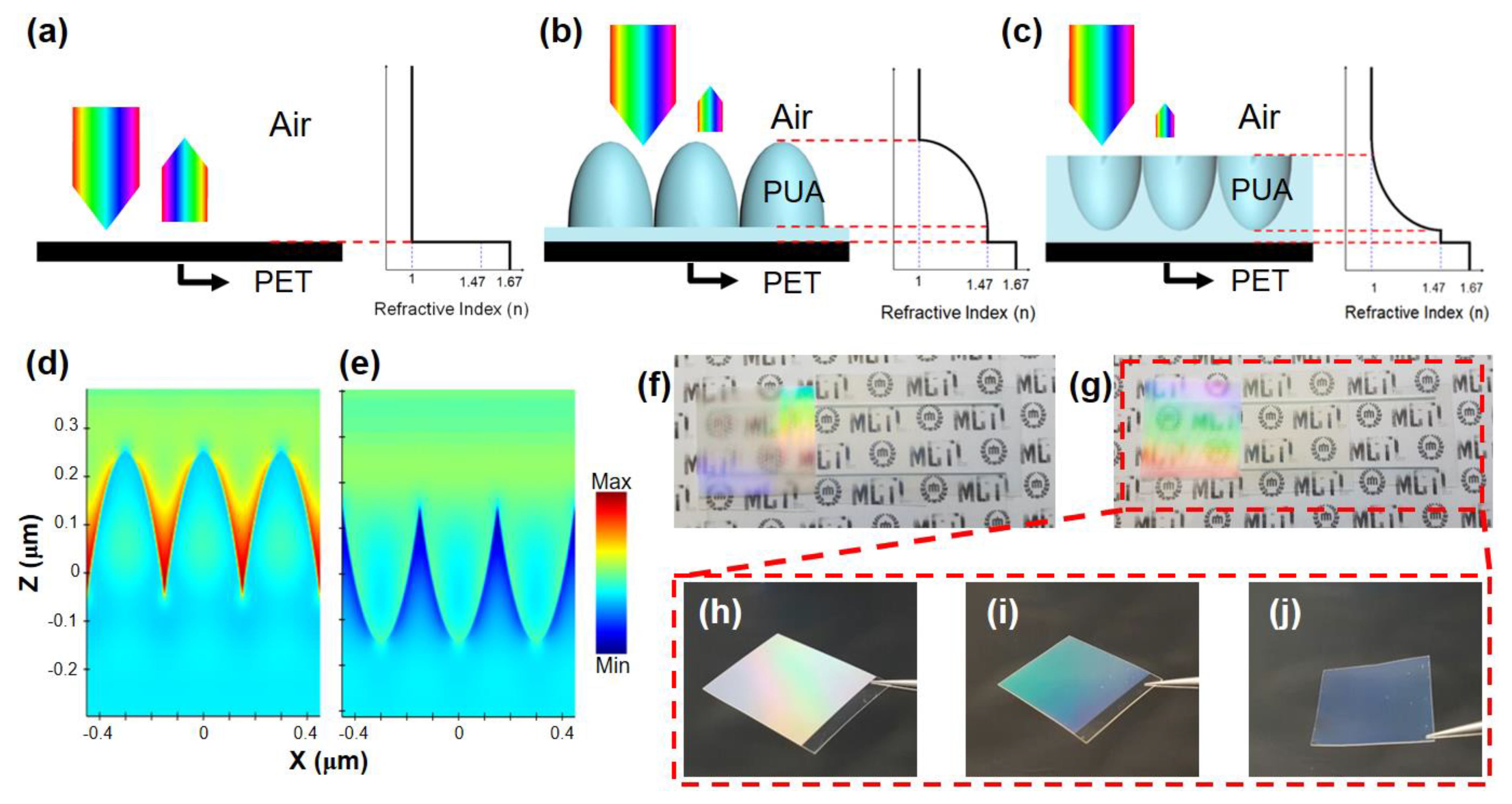Optimization of Shapes and Sizes of Moth-Eye-Inspired Structures for the Enhancement of Their Antireflective Properties
Abstract
1. Introduction
2. Materials and Methods
2.1. Preparation of 300, 500, and 1000 nm Moth-Eye Silicon Masters
2.2. Fabrication of PUA Moth-Eye Structures
2.3. Characterization
3. Results and Discussion
3.1. Fabrication of Antireflective Moth-Eye Patterned Surfaces
3.2. Specific Shapes of MPS and IMPS Based on SEM Analyses
3.3. Effect of Antireflective MPS
3.4. Structural Analysis of MPS to Prevent Reflections
4. Conclusions
Author Contributions
Funding
Conflicts of Interest
References
- Song, Y.M.; Choi, H.J.; Yu, S.J.; Lee, Y.T. Des. of highly transparent glasses with broadband antireflective subwavelength structures. Opt. Express 2010, 18, 13063. [Google Scholar] [CrossRef]
- Ji, S.; Song, K.; Nguyen, T.B.; Kim, N.; Lim, H. Optimal moth eye nanostructure array on transparent glass towards broadband antireflection. ACS Appl. Mater. Interfaces 2013, 5, 10731–10737. [Google Scholar] [CrossRef] [PubMed]
- Choi, K.; Park, S.H.; Song, Y.M.; Lee, Y.T.; Hwangbo, C.K.; Yang, H.; Lee, H.S. Nano-tailoring the surface structure for the monolithic high-performance antireflection polymer film. Adv. Mater. 2010, 22, 3713–3718. [Google Scholar] [CrossRef] [PubMed]
- Sainiemi, L.; Jokinen, V.; Shah, A.; Shpak, M.; Aura, S.; Suvanto, P.; Franssila, S. Non-reflecting silicon and polymer surfaces by plasma etching and replication. Adv. Mater. 2011, 23, 122–126. [Google Scholar] [CrossRef] [PubMed]
- Kiraly, B.; Yang, S.; Huang, T.J. Multifunctional porous silicon nanopillar arrays: antireflection, superhydrophobicity, photoluminescence, and surface-enhanced Raman scattering. Nanotechnology 2013, 24, 245704. [Google Scholar] [CrossRef]
- Kuo, W.K.; Hsu, J.J.; Nien, C.K.; Yu, H.H. Moth-Eye-Inspired Biophotonic Surfaces with Antireflective and Hydrophobic Characteristics. ACS Appl. Mater. Interfaces 2016, 8, 32021–32030. [Google Scholar] [CrossRef]
- Liu, D.; Wang, Q.; Shen, W.; Wang, D. Self-cleaning antireflective coating with a hierarchical texture for light trapping in micromorph solar cells. J. Mater. Chem. C 2017, 5, 103–109. [Google Scholar] [CrossRef]
- Leem, J.W.; Kim, S.; Lee, S.H.; Rogers, J.A.; Kim, E.; Yu, J.S. Efficiency Enhancement of Organic Solar Cells Using Hydrophobic Antireflective Inverted Moth-Eye Nanopatterned PDMS Films. Adv. Energy Mater. 2014, 4. [Google Scholar] [CrossRef]
- Ko, D.-H.; Tumbleston, J.R.; Henderson, K.J.; Euliss, L.E.; DeSimone, J.M.; Lopez, R.; Samulski, E.T. Biomimetic microlens array with antireflective “moth-eye” surface. Soft Matter 2011, 7. [Google Scholar] [CrossRef]
- Tan, G.; Lee, J.-H.; Lan, Y.-H.; Wei, M.-K.; Peng, L.-H.; Cheng, I.-C.; Wu, S.-T. Broadband antireflection film with moth-eye-like structure for flexible display applications. Optica 2017, 4, 678. [Google Scholar] [CrossRef]
- An, S.; Jo, H.S.; Kim, Y.I.; Song, K.Y.; Kim, M.W.; Lee, K.B.; Yarin, A.L.; Yoon, S.S. Bio-inspired, colorful, flexible, defrostable light-scattering hybrid films for the effective distribution of LED light. Nanoscale 2017, 9, 9139–9147. [Google Scholar] [CrossRef] [PubMed]
- Mizoshita, N.; Tanaka, H. Versatile Antireflection Coating for Plastics: Partial Embedding of Mesoporous Silica Nanoparticles onto Substrate Surface. ACS Appl. Mater. Interfaces 2016, 8, 31330–31338. [Google Scholar] [CrossRef] [PubMed]
- Li, Y.; Jiang, T.; He, X.; Zhang, Y.; Fang, C.; Li, Z.; Lin, J.; Zhuang, Y. Cylindrical lens array concentrator with a nanonipple-array antireflective surface for improving the performances of solar cells. Opt. Commun. 2019, 439, 118–124. [Google Scholar] [CrossRef]
- Luo, X.; Lu, L.; Yin, M.; Fang, X.; Chen, X.; Li, D.; Yang, L.; Li, G.; Ma, J. Antireflective and self-cleaning glass with robust moth-eye surface nanostructures for photovoltaic utilization. Mater. Res. Bull. 2019, 109, 183–189. [Google Scholar] [CrossRef]
- Kang, S.M.; Jang, S.; Lee, J.K.; Yoon, J.; Yoo, D.E.; Lee, J.W.; Choi, M.; Park, N.G. Moth-Eye TiO2 Layer for Improving Light Harvesting Efficiency in Perovskite Solar Cells. Small 2016, 12, 2443–2449. [Google Scholar] [CrossRef] [PubMed]
- Heo, S.Y.; Koh, J.K.; Kang, G.; Ahn, S.H.; Chi, W.S.; Kim, K.; Kim, J.H. Bifunctional Moth-Eye Nanopatterned Dye-Sensitized Solar Cells: Light-Harvesting and Self-Cleaning Effects. Adv. Energy Mater. 2014, 4. [Google Scholar] [CrossRef]
- Cordaro, A.; van de Groep, J.; Raza, S.; Pecora, E.F.; Priolo, F.; Brongersma, M.L. Antireflection High-Index Metasurfaces Combining Mie and Fabry-Pérot Resonances. ACS Photonics 2019, 6, 453–459. [Google Scholar] [CrossRef]
- Shao, T.; Tang, F.; Sun, L.; Ye, X.; He, J.; Yang, L.; Zheng, W. Fabrication of Antireflective Nanostructures on a Transmission Grating Surface Using a One-Step Self-Masking Method. Nanomaterials (Basel) 2019, 9, 180. [Google Scholar] [CrossRef] [PubMed]
- Li, Y.; Zhang, J.; Yang, B. Antireflective surfaces based on biomimetic nanopillared arrays. Nano Today 2010, 5, 117–127. [Google Scholar] [CrossRef]
- Yao, L.; Qu, Z.; Pang, Z.; Li, J.; Tang, S.; He, J.; Feng, L. Three-Layered Hollow Nanospheres Based Coatings with Ultrahigh-Performance of Energy-Saving, Antireflection, and Self-Cleaning for Smart Windows. Small 2018, 14, e1801661. [Google Scholar] [CrossRef] [PubMed]
- Guldin, S.; Kohn, P.; Stefik, M.; Song, J.; Divitini, G.; Ecarla, F.; Ducati, C.; Wiesner, U.; Steiner, U. Self-cleaning antireflective optical coatings. Nano Lett. 2013, 13, 5329–5335. [Google Scholar] [CrossRef] [PubMed]
- Feng, C.; Zhang, Z.; Li, J.; Qu, Y.; Xing, D.; Gao, X.; Zhang, Z.; Wen, Y.; Ma, Y.; Ye, J.; et al. A Bioinspired, Highly Transparent Surface with Dry-Style Antifogging, Antifrosting, Antifouling, and Moisture Self-Cleaning Properties. Macromol. Rapid Commun. 2019, 40, e1800708. [Google Scholar] [CrossRef] [PubMed]
- Lotz, M.R.; Petersen, C.R.; Markos, C.; Bang, O.; Jakobsen, M.H.; Taboryski, R. Direct nanoimprinting of moth-eye structures in chalcogenide glass for broadband antireflection in the mid-infrared. Optica 2018, 5. [Google Scholar] [CrossRef]
- Kim, M.-c.; Jang, S.; Choi, J.; Kang, S.M.; Choi, M. Moth-eye Structured Polydimethylsiloxane Films for High-Efficiency Perovskite Solar Cells. Nano-Micro Lett. 2019, 11. [Google Scholar] [CrossRef]
- Kesmez, Ö.; Akarsu, E.; Çamurlu, H.E.; Yavuz, E.; Akarsu, M.; Arpaç, E. Preparation and characterization of multilayer anti-reflective coatings via sol-gel process. Ceram. Int. 2018, 44, 3183–3188. [Google Scholar] [CrossRef]
- Jilavi, M.H.; Mousavi, S.H.; Müller, T.S.; de Oliveira, P.W. Dual functional porous anti-reflective coatings with a photocatalytic effect based on a single layer system. Appl. Surf. Sci. 2018, 439, 323–328. [Google Scholar] [CrossRef]
- Xiao, L.; Lv, Y.; Dong, W.; Zhang, N.; Liu, X. Dual-Functional WO3 Nanocolumns with Broadband Antireflective and High-Performance Flexible Electrochromic Properties. ACS Appl. Mater. Interfaces 2016, 8, 27107–27114. [Google Scholar] [CrossRef]
- Eichhorn, S.J. Cellulose nanowhiskers: promising materials for advanced applications. Soft Matter 2011, 7, 303–315. [Google Scholar] [CrossRef]
- Yang, S.; Sun, N.; Stogin, B.B.; Wang, J.; Huang, Y.; Wong, T.S. Ultra-antireflective synthetic brochosomes. Nat. Commun. 2017, 8, 1285. [Google Scholar] [CrossRef]
- Raut, H.K.; Dinachali, S.S.; Loke, Y.C.; Ganesan, R.; Ansah-Antwi, K.K.; Gora, A.; Khoo, E.H.; Ganesh, V.A.; Saifullah, M.S.; Ramakrishna, S. Multiscale ommatidial arrays with broadband and omnidirectional antireflection and antifogging properties by sacrificial layer mediated nanoimprinting. ACS Nano 2015, 9, 1305–1314. [Google Scholar] [CrossRef]
- Xie, D.; Yang, Z.; Liu, X.; Cui, S.; Zhou, H.; Fan, T. Broadband omnidirectional light reflection and radiative heat dissipation in white beetles Goliathus goliatus. Soft Matter 2019, 15, 4294–4300. [Google Scholar] [CrossRef] [PubMed]




© 2020 by the authors. Licensee MDPI, Basel, Switzerland. This article is an open access article distributed under the terms and conditions of the Creative Commons Attribution (CC BY) license (http://creativecommons.org/licenses/by/4.0/).
Share and Cite
Choi, J.S.; An, J.H.; Lee, J.-K.; Lee, J.Y.; Kang, S.M. Optimization of Shapes and Sizes of Moth-Eye-Inspired Structures for the Enhancement of Their Antireflective Properties. Polymers 2020, 12, 296. https://doi.org/10.3390/polym12020296
Choi JS, An JH, Lee J-K, Lee JY, Kang SM. Optimization of Shapes and Sizes of Moth-Eye-Inspired Structures for the Enhancement of Their Antireflective Properties. Polymers. 2020; 12(2):296. https://doi.org/10.3390/polym12020296
Chicago/Turabian StyleChoi, Ji Seong, Joon Hyung An, Jong-Kwon Lee, Ji Yun Lee, and Seong Min Kang. 2020. "Optimization of Shapes and Sizes of Moth-Eye-Inspired Structures for the Enhancement of Their Antireflective Properties" Polymers 12, no. 2: 296. https://doi.org/10.3390/polym12020296
APA StyleChoi, J. S., An, J. H., Lee, J.-K., Lee, J. Y., & Kang, S. M. (2020). Optimization of Shapes and Sizes of Moth-Eye-Inspired Structures for the Enhancement of Their Antireflective Properties. Polymers, 12(2), 296. https://doi.org/10.3390/polym12020296




